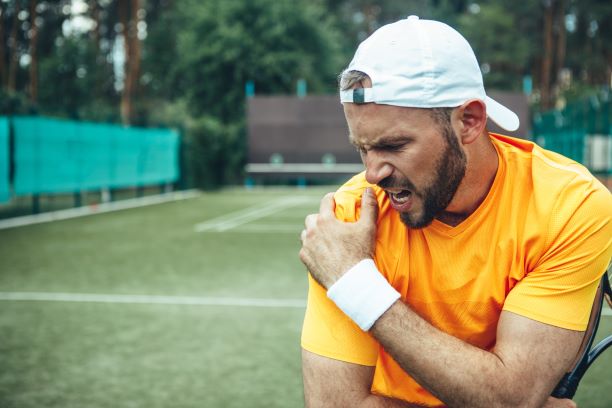Your shoulder is the most mobile joint in your body. However, it is also the most often dislocated joint. Shoulder dislocations are common in active people under 25 years old. About 200,000 shoulder dislocations occur in the U.S. each year. Surgery or non-surgical treatments are available. 5 types of exercises are required for you to recover without surgery.
Multiple structures become injured after a shoulder dislocation. Your ligaments tear. Your labrum and rotator cuff are injured. And some people experience bone bruising or fractures. Because of the complexity of these injuries, rehab is comprehensive. Your shoulder will not recover with passing time. You need to take rehab seriously.

Shoulder Dislocations: A Proven Exercise Approach
A 2020 study published in The Orthopaedic Journal of Sports Medicine looked at 56 patients after a shoulder dislocation. Half of the patients performed a generic home exercise program. These exercises targeted range of motion and strength. The other half performed specialized exercises supervised by a physical therapist.
After 12 weeks, the group performing the specialized exercises achieved nearly 50% greater improvement in pain and function. Also, 25% of the patients performing the home exercises eventually required surgery, compared to only 11% in the specialized exercise group.
5 Important Types of Exercise After a Shoulder Dislocation
The rest of this article highlights 5 of the keys to an individually tailored exercise program after a shoulder dislocation.
- Controlled Early Range of Motion
- Scapula Control Exercises
- Dynamic Stabilization Exercises
- Rotator Cuff Strengthening Exercises
- Proprioceptive Exercises
Controlled Early Range of Motion
After a shoulder dislocation, your damaged shoulder needs time to heal. This involves a very short period of rest in a sling. The length depends on many factors, like your age and activity levels. Your doctor will make this determination.
Your physical therapist will individually prescribe the right exercises for you. Exercises will protect healing tissues so you don’t suffer a second dislocation. Also, it is important to maintain and slowly restore your mobility so you don’t lose it for good.
Follow your physical therapist’s recommendations closely. In most cases, gentle range of motion exercises begins within 1 or 2 weeks of your injury. Supine shoulder flexion and the forward bow are 2 excellent exercises used early during rehab.
Scapula Control Exercises
Your scapula, or shoulder blade, makes up half of your shoulder joint, along with your upper arm. Your shoulder blade is the base for your entire arm. It has many important muscle attachments. You have to be able to control the position and movement of your shoulder blade. This enhances stability and reduces your risk for dislocations. Your first step is to properly activate your middle and lower trapezius muscles. Practice this every day.
Dynamic Stabilization Exercises
Dynamic stability refers to your muscle’s ability to hold the head of your humerus in the socket. Passive stability refers to your ligaments and joint capsule. Muscle and nerve function is dynamic.
Dynamic stability occurs during daily use when your muscles and nervous system respond on time and with sufficient force. Let’s say you fall on your shoulder. If your muscles and nerves respond too slow or with not enough force, you will dislocate your shoulder.
Exercises that target coordination and timing retrain your dynamic stability. Early during rehab, your physical therapist will perform exercises using their hands as manual resistance. This improves your ability to react to external forces. As you progress in rehab you will utilize various tools to train dynamic stability. Bodyblade exercises are included in most programs.
Rotator Cuff Strengthening Exercises
Your rotator cuff functions to hold the head of your humerus bone in the socket of your shoulder blade. Essentially the 4 muscles of your rotator cuff keep the ball in the socket. The rotator cuff muscles respond rapidly when your shoulder is challenged. They must have excellent strength and endurance to do their job properly. If not, you are at risk for another dislocation.
There are many excellent exercises to strengthen your rotator cuff. Start with side-lying external rotation. And do these exercises at least 3 days per week. Perform 3 to 4 sets of 10 to 20 reps with low loads. Light weights, 2 or 3 pounds, gets the job done at first.
Proprioceptive Exercises
Proprioception refers to an awareness of where your body is in space. For example, closing your eyes and touching your finger to your nose requires proprioception. This is able to happen because of small specialized nerve endings in your muscles, tendons, and joints.
After a shoulder dislocation, nerve endings and pathways become disrupted. Restoring these pathways requires specialized exercise.
Early during rehab, you are prescribed exercises that require you to reposition your shoulder in various positions. These exercises require ongoing feedback from your therapist. As you progress in your rehab, you will perform exercises on unstable surfaces like a balance board or BOSU ball.
Get Help From Your Physical Therapist
Rehab after shoulder dislocations require a delicate balance. On the 1 hand, you have to perform the right exercises correctly without overstressing your healing tissues. Multiple dislocations are common, especially in younger people.
On the other hand, your shoulder will not get better on its own. You need to move it to regain your range of motion. And you need to improve your strength, stability, and proprioception in order to regain function. This requires the help of your physical therapist.
So don’t delay your rehab. Call your physical therapist to get started on your road to recovery. The doctors of physical therapy at BSR have been helping people in Southern Ocean County with painful shoulders since 2007. We are here to help you move without pain.


